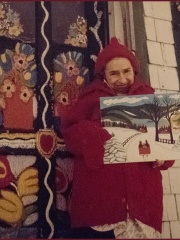

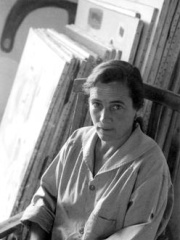
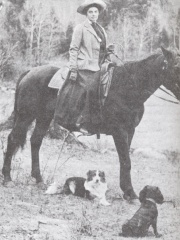
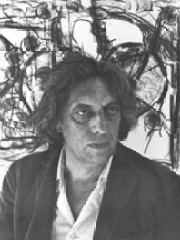
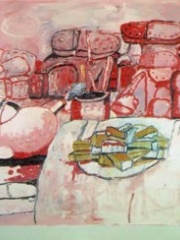
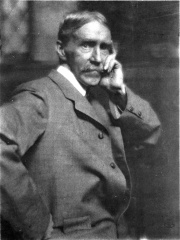
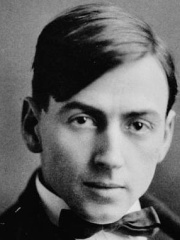
The Most Famous
PAINTERS from Canada
Top 10
The following people are considered by Pantheon to be the top 10 most legendary Canadian Painters of all time. This list of famous Canadian Painters is sorted by HPI (Historical Popularity Index), a metric that aggregates information on a biography's online popularity. Visit the rankings page to view the entire list of Canadian Painters.

1. Maud Lewis (1903 - 1970)
With an HPI of 62.27, Maud Lewis is the most famous Canadian Painter. Her biography has been translated into 22 different languages on wikipedia.
Maud Kathleen Lewis (née Dowley; March 7, 1903 – July 30, 1970) was a Canadian folk artist from Nova Scotia. She lived most of her life in poverty in a tiny house in Marshalltown, Nova Scotia. She achieved national recognition in 1964 and 1965 for her cheerful paintings of landscapes, animals and flowers, which offer a nostalgic and optimistic vision of her native province. Several books, plays and films have been produced about her. She remains one of Canada's most celebrated folk artists. Her works are displayed at the Art Gallery of Nova Scotia, as well as her restored house, whose walls she adorned with her art. Despite her recognition, Lewis never had a museum exhibition, nor was her work collected by art galleries or museums during her lifetime.

2. Jeff Wall (b. 1946)
With an HPI of 60.65, Jeff Wall is the 2nd most famous Canadian Painter. His biography has been translated into 24 different languages.
Jeffrey Jeff Wall, OC, RSA (born September 29, 1946) is a Canadian photographer. He is an artist best known for his large-scale back-lit Cibachrome photographs and art history writing. Early in his career, he helped define the Vancouver School and he has published essays on the work of his colleagues and fellow Vancouverites Rodney Graham, Ken Lum, and Ian Wallace. His photographic tableaux often take Vancouver's mixture of natural beauty, urban decay, and postmodern and industrial featurelessness as their backdrop.

3. Agnes Martin (1912 - 2004)
With an HPI of 58.70, Agnes Martin is the 3rd most famous Canadian Painter. Her biography has been translated into 23 different languages.
Agnes Bernice Martin (March 22, 1912 – December 16, 2004) was a Canadian-American abstract painter known for her minimalist style and abstract expressionism. Born in Saskatchewan, she moved to the United States in 1931, where she pursued higher education and became a U.S. citizen in 1950. Martin's artistic journey began in New York City, where she immersed herself in modern art and developed a deep interest in abstraction. Despite often being labeled a minimalist, she identified more with abstract expressionism. Her work has been defined as an "essay in discretion, inwardness and silence." Growing up in rural Canada and influenced by the New Mexico desert, where she lived for the last several decades of her life, Martin's art was characterized by serene compositions featuring grids and lines. Her works were predominantly monochromatic, employing colors like black, white, and brown with great subtlety. Martin's minimalist approach conveyed tranquility and spirituality, and her paintings often carried positive names reflective of her philosophy. Her career included numerous exhibitions, totaling over 85 solo shows, and participation in major events such as the Venice Biennale and Documenta. Martin's work earned recognition for its unique contribution to contemporary art, and she received awards like the National Medal of Arts from the National Endowment for the Arts in 1998. She was elected to the Royal Canadian Academy of Arts in 2004. Despite personal struggles with schizophrenia, Martin's dedication to her art persisted, and her legacy continues to inspire contemporary artists. Documentaries and films have explored her life and work, shedding light on her artistic process and impact. Beyond the art world, her influence extends to popular culture, as seen in a Google doodle and a song dedicated to her. Martin's artistic vision, blending minimalism and spirituality, remains an enduring and influential force in the realm of abstract art.

4. Emily Carr (1871 - 1945)
With an HPI of 58.46, Emily Carr is the 4th most famous Canadian Painter. Her biography has been translated into 30 different languages.
Emily Carr (December 13, 1871 – March 2, 1945) was a Canadian artist who was inspired by the monumental art and villages of the First Nations and the landscapes of British Columbia. She also was a vivid writer and chronicler of life in her surroundings, praised for her "complete candour" and "strong prose". Klee Wyck, her first book, published in 1941, won the Governor General's Literary Award for non-fiction and this book and others written by her or compiled from her writings later are still much in demand today. Carr's keynote paintings, such as The Indian Church (1929), were not widely known in Canada at first. But her stature as one of Canada's most important artists continued to grow. Today, she is considered a cherished, even revered figure of Canadian arts and letters. Scholars and the public alike regard her as a Canadian national treasure and the Canadian Encyclopedia describes her as a Canadian icon. She has been designated a National Historic Person and had a Minor planet 5688 Kleewyck named after her anglicized native name (Klee Wyck). As one scholar in her 2014 book on Carr, put it, "we love her and she continues to speak to us". Emily Carr lived most of her life in the city in which she was born and died, Victoria, British Columbia.

5. John McCrae (1872 - 1918)
With an HPI of 57.00, John McCrae is the 5th most famous Canadian Painter. His biography has been translated into 27 different languages.
Lieutenant-Colonel John McCrae (November 30, 1872 – January 28, 1918) was a Canadian poet, physician, author, artist and soldier during World War I and a surgeon during the Second Battle of Ypres, in Belgium. He is best known for writing the famous war memorial poem "In Flanders Fields". McCrae died of pneumonia near the end of the war. His famous poem is a threnody, a genre of lament.

6. Jean-Paul Riopelle (1923 - 2002)
With an HPI of 55.96, Jean-Paul Riopelle is the 6th most famous Canadian Painter. His biography has been translated into 18 different languages.
Jean-Paul Riopelle, (October 7, 1923 – March 12, 2002) was a Canadian painter and sculptor from Quebec. He had one of the longest and most important international careers of the sixteen signatories of the Refus Global, the 1948 manifesto that announced the Quebecois artistic community's refusal of clericalism and provincialism. He is best known for his abstract painting style, in particular his "mosaic" works of the 1950s when he famously abandoned the paintbrush, using only a palette knife to apply paint to canvas, giving his works a distinctive sculptural quality. He became the first Canadian painter since James Wilson Morrice to attain widespread international recognition and high praise, both during his career and after his death. He was a leading artist of French Lyrical Abstraction.

7. Philip Guston (1913 - 1980)
With an HPI of 55.96, Philip Guston is the 7th most famous Canadian Painter. His biography has been translated into 24 different languages.
Philip Guston (born Phillip Goldstein, June 27, 1913 – June 7, 1980) was a Canadian American painter, printmaker, muralist and draftsman. "Guston worked in a number of artistic modes, from Renaissance-inspired figuration to formally accomplished abstraction," and is now regarded as one of the "most important, powerful, and influential American painters of the last 100 years". He frequently depicted racism, antisemitism, fascism and American identity, as well as—especially in his later most cartoonish and mocking work—the banality of evil. In 2013, Guston's painting To Fellini set an auction record at Christie's when it sold for US$25.8 million. Guston was a founding figure in the mid-century New York School, which established New York as the new center of the global art world, and his work appeared in the famed Ninth Street Show and in the avant-garde art journal It is. A Magazine for Abstract Art. By the 1960s, Guston had renounced abstract expressionism and was helping pioneer a modified form of representational art known as neo-expressionism. "Calling American abstract art 'a lie' and 'a sham,' he pivoted to making paintings in a dark, figurative style, including satirical drawings of Richard Nixon" during the Vietnam War as well as several paintings of hooded Klansmen, which Guston explained this way: "They are self-portraits ... I perceive myself as being behind the hood ... The idea of evil fascinated me ... I almost tried to imagine that I was living with the Klan." The paintings of Klan figures were set to be part of an international retrospective sponsored by the National Gallery of Art, the Tate Modern, the Museum of Fine Arts, Houston, and the Museum of Fine Arts, Boston in 2020, but in late September, the museums jointly postponed the exhibition until 2024, "a time at which we think that the powerful message of social and racial justice that is at the center of Philip Guston's work can be more clearly interpreted." The announcement spurred an open letter, published online by The Brooklyn Rail and signed by more than 2,000 artists. It criticizes the postponement and the museums' lack of courage to display or attempt to interpret Guston's work, as well as the museums' own "history of prejudice". It calls Guston's KKK themes a timely catalyst for a "reckoning" with cultural and institutional white supremacy, and argues that that is why the exhibition must proceed without delay. On October 28, 2020, the museums announced earlier exhibition dates starting in 2022.

8. Maurice Prendergast (1858 - 1924)
With an HPI of 52.64, Maurice Prendergast is the 8th most famous Canadian Painter. His biography has been translated into 16 different languages.
Maurice Brazil Prendergast (October 10, 1858 – February 1, 1924) was a Newfoundlander-American artist who painted in oil and watercolor, and created monotypes. His delicate landscapes and scenes of modern life, characterized by mosaic-like color, are generally associated with Post-Impressionism. Prendergast, however, was also a member of The Eight, a group of early twentieth-century American artists who, aside from Prendergast, represented the Ashcan School.

9. Tom Thomson (1877 - 1917)
With an HPI of 52.54, Tom Thomson is the 9th most famous Canadian Painter. His biography has been translated into 20 different languages.
Thomas John Thomson (August 5, 1877 – July 8, 1917) was a Canadian artist active in the early 20th century. During his short career, he produced roughly 400 oil sketches on small wood panels and approximately 50 larger works on canvas. His works consist almost entirely of landscapes, depicting trees, skies, lakes, and rivers. He used broad brush strokes and a liberal application of paint to capture the beauty and colour of the Ontario landscape. Thomson is considered by many Canadians as the archetypal painter, and his later work has heavily influenced Canadian art – paintings such as The Jack Pine and The West Wind have taken a prominent place in the culture of Canada and are some of the country's most iconic works. His accidental death by drowning at 39 shortly before the founding of the Group of Seven is seen as a tragedy for Canadian art. Raised in rural Ontario, Thomson was born into a large family of farmers and displayed no immediate artistic talent. He worked several jobs before attending a business college, eventually developing skills in penmanship and copperplate writing. At the turn of the 20th century, he was employed in Seattle and Toronto as a pen artist at several different photoengraving firms, including Grip Ltd. There he met those who eventually formed the Group of Seven, including J. E. H. MacDonald, Lawren Harris, Frederick Varley, Franklin Carmichael and Arthur Lismer. In May 1912, he visited Algonquin Park—a major public park and forest reservation in Central Ontario—for the first time. It was there that he acquired his first sketching equipment and, following MacDonald's advice, began to capture nature scenes. He became enraptured with the area and repeatedly returned, typically spending his winters in Toronto and the rest of the year in the Park. His earliest paintings were not outstanding technically, but showed a good grasp of composition and colour handling. His later paintings vary in composition and contain vivid colours and thickly applied paint. Thomson developed a reputation during his lifetime as a veritable outdoorsman, talented in both fishing and canoeing, although his skills in the latter have been contested. The circumstances of his drowning on Canoe Lake in Algonquin Park, linked with his image as a master canoeist, led to unsubstantiated but persistent rumours that he had been murdered or committed suicide. Although he died before the formal establishment of the Group of Seven, Thomson is often considered an unofficial member. His art is typically exhibited with the rest of the Group's, nearly all of which remains in Canada—mainly at the Art Gallery of Ontario in Toronto, the National Gallery of Canada in Ottawa, the McMichael Canadian Art Collection in Kleinburg and the Tom Thomson Art Gallery in Owen Sound.

10. Rob Gonsalves (1959 - 2017)
With an HPI of 52.38, Rob Gonsalves is the 10th most famous Canadian Painter. Her biography has been translated into 21 different languages.
Robert "Rob" Gonsalves (July 10, 1959 – June 14, 2017) was a Canadian painter of magic realism (surrealism). He produced original works, limited edition prints and illustrations for his own books.
People
Pantheon has 10 people classified as Canadian painters born between 1858 and 1959. Of these 10, 1 (10.00%) of them are still alive today. The most famous living Canadian painters include Jeff Wall. The most famous deceased Canadian painters include Maud Lewis, Agnes Martin, and Emily Carr.
Living Canadian Painters
Go to all RankingsDeceased Canadian Painters
Go to all RankingsMaud Lewis
1903 - 1970
HPI: 62.27
Agnes Martin
1912 - 2004
HPI: 58.70
Emily Carr
1871 - 1945
HPI: 58.46
John McCrae
1872 - 1918
HPI: 57.00
Jean-Paul Riopelle
1923 - 2002
HPI: 55.96
Philip Guston
1913 - 1980
HPI: 55.96
Maurice Prendergast
1858 - 1924
HPI: 52.64
Tom Thomson
1877 - 1917
HPI: 52.54
Rob Gonsalves
1959 - 2017
HPI: 52.38
Overlapping Lives
Which Painters were alive at the same time? This visualization shows the lifespans of the 8 most globally memorable Painters since 1700.

